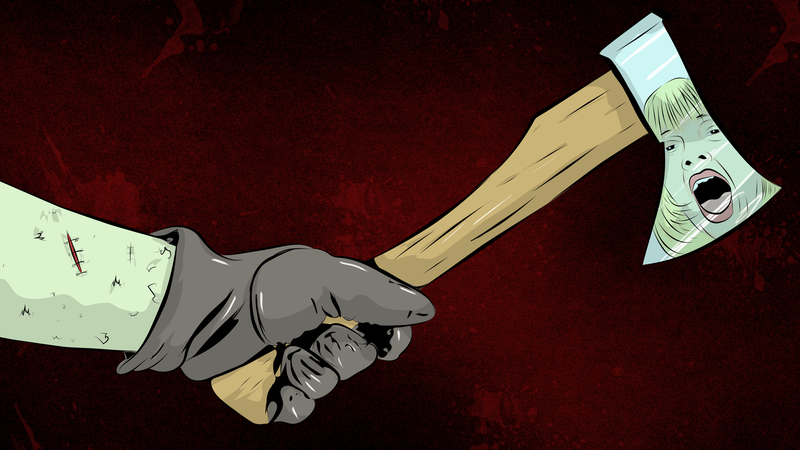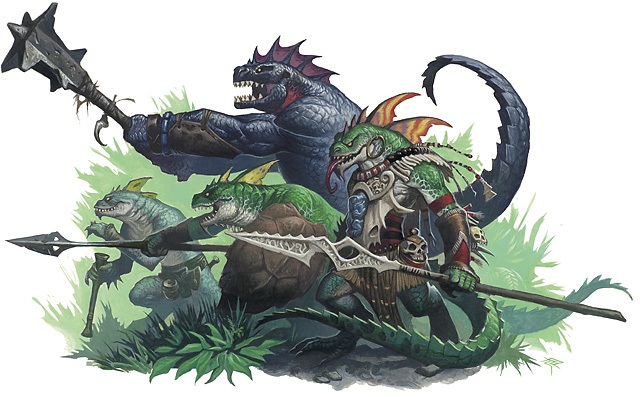
Musing about tabletop gaming. In particular, about tabletop RPGs--the various editions [and clones] of "the world's most popular, fantasy role-playing game;" Palladium's "Megaversal" system; Battletech & Mechwarrior; d20 Star Wars; FATE; as well as home-brew settings and game systems.
Wednesday, September 13, 2017
Undying of Monvesia
In some settings, the undead are the creation of bored, evil gods who seek to terrorize the mortal world. In Monvesia, they are a natural offshoot of the transitive region of the Necrosphere. This region goes by several names: the Plane of Shadow, the Plane of Fear, the Domains of Dread, the Nightmare Realm. All undead are powered by this place, and it is in this place that the most powerful of their kind have come to live eternally and rule over their fellows. These are the Undying who make pacts with warlocks.


Tuesday, August 29, 2017
Archfey of Monvesia
The archfey of Monvesia have already been visited briefly in the warlock entry of Mages of Monvesia. Here I will explore each of the chief, five archfey in some detail. Though each of the archfey represent one race or another, all are unique and powerful creatures.


Labels:
5th edition,
archfey,
Dynasphere,
elves,
Feywild,
inner planes,
Monvesia,
warlocks
Friday, August 11, 2017
Classifying Monvesian Creatures
RETCON NOTE: Portions of this posts are sysematically being replaced by a series of posts under the heading of "Classifying Monvesian Creatures":
- Aberrations, Celestials, Fiends
- Anachromisms, Doubles, Thoughtforms
- Beasts & Monstrosities
- Divinities
- Elementals
- Fey [& Plants]
- Humanoids & Giants
- Undead
General information about creature classification in this setting will remain in this post.
As has been pointed out in previous posts, the nature of Monvesia is different from that other D&D worlds. To accommodate these differences, there needs to be some minor shuffling of creatures. A few new monster types have even been created. The creature types of Monvesia are listed below, showing those both new and altered.
Beasts
Many creatures normally classified as monstrocities are included among the beasts of Monvesia.
- Catoblepas [beast]
- Roc [beast]
Daemons (Multiple Types)
Daemons are a family of several monster types, each tied to one of the three-Sphere transitive planes. Five of these types already exist in the game, and three are new: Aberrations, Anachronisms, Doubles, Celestials, Fey, Fiends, Thoughforms, and Undead.
Labels:
5th edition,
anachronisms,
celestials,
daemons,
divinities,
doubles,
dragons,
elementals,
fey,
fiends,
monsters,
Monvesia,
thoughtforms,
undead
Wednesday, August 9, 2017
Foolishness Check
While running a "summer slasher flick" one-off adventure for d20 Modern, I wanted to make sure that the characters still acted like the idiots we normally see in horror films--particularly since all my players were horror fans, and certainly knew better. Below is the mechanic I settled on. It added a sense of plausibility to the genre, and the players loved it.
Since the trope ultimately has its origins in gothic literature, the Foolishness Check would also be appropriate in a gothic fantasy setting/story. It may now, however, be used as frequently as in a modern horror game with victim-style characters. Since that slasher game, I have kept the mechanic in my back pocket to use whenever I feel the need.

Monday, August 7, 2017
Elementals of Monvesia
In order to accommodate a world with a paradigm that includes six elemental forces, new monsters need to be introduced in order to support them. Below are new variants on creatures fundamental to the game: elementals and genies of light and void.

Elementals

Light Elemental
A light elemental is a radiant personage hovering in midair; its exact features are hard to distinguish, but limbs and head are often discernible. Sometimes, it appears as little more than a pillar of light. As a being of pure radiance, it is the fastest of all elementals--gliding through the air or across the land with equal ease.Friday, August 4, 2017
Monvesian Culture: Rakasta Qrisjarr
Qrisjarr (KREE-sharr) are artisan blades crafted in the rakasta tradition. Each blade has an asymmetrical wave shape, and a distinctive blade-patterning common to the tjakeer steel used to make them. Each weapon is unique, built on a common pattern with several opportunities for personal choice and artistic expression. These weapons are treasures, but are more valuable than their mere monetary cost.
Qrisjarr are given as gifts by njanarr* to warriors who have proven to be brave, skilled, and who embody rakasta honor--which includes a "healthy" dose of arrogance. They are as much a symbol of status as they are combat tools. Anyone gifted qrisjarr is considered a djiqic, a rakasta knight. To wield a qrisj without having been given this honor is an insult. Any non-rakasta with one is treated with suspicion until a rakasta of standing (djiqic, elder, shaman, or njan) can confirm the bearer's status.

Qrisjarr are given as gifts by njanarr* to warriors who have proven to be brave, skilled, and who embody rakasta honor--which includes a "healthy" dose of arrogance. They are as much a symbol of status as they are combat tools. Anyone gifted qrisjarr is considered a djiqic, a rakasta knight. To wield a qrisj without having been given this honor is an insult. Any non-rakasta with one is treated with suspicion until a rakasta of standing (djiqic, elder, shaman, or njan) can confirm the bearer's status.

Monvesia Culture: Rakasta Language
In the process of drafting a post on ceremonial weapons from years-old notes, I took the time to explore the rakasta language. I pulled in two location names of supposed rakasta origin--Zyrndy and Tamyya--and incorporated them into a standardized "transliteration." From there, I was able to identify what sounds would be used in a rakasta alphabet (instead of using elfish runes as previously suggested).
Outlined below are the letters I have used to write rakasta words with [the basic sounds they represent] and (the Turkish letters they replace). While the sounds do not exactly correspond to the sounds of Turkish, these correspondences are useful when transforming a Turkish root to a rakasta word.
- Vowels: A [ah] (a); E [ay] (e); I [ee] (ı, i); O [oh] (o, ö); U [oo] (u); Y [i~u] (ü).
- Plosives: C [t~k] (k, t); D [d~g] (d, g); P [p~f] (f, p); Q [gutteral k~g] (k, g); V [b~v] (b, v); ' [glottal stop] (ğ).
- Nasals: M [m] (m); Mj [mi, my] (n/a); N [n] (n); Nj [ni, ny] (n/a). (mj and nj are unique rakasta sounds that can be used in place if Turkish y)
- Fricatives: Cj [ch] (ç); Dj [j, soft g] (c); S [s] (s); Sj [sh] (ş); X [x, ch] (h); Z [z] (z); Zj [zh] (j).
- Rhotics: R [flap or trill r] (l); Rr [gutteral r] (r).
Thursday, July 20, 2017
Lizardfolk of Henjal

-----
Language Analog: Lizardfolk speak dialects of the monster language Draconic, which has no real-world analog.
Inspiration: Traditional lizardfolk from the various editions of D&D.
Lizardfolk, in BD&D, are just a monster. I had not considered their overall place in the world when I made them the inhabitants of the Temple of Akhnaphar. Their presentation in that adventure is "explained" here.
They are presented as a playable race in 5th edition in Volo's Guide to Monsters. As lizardfolk are rare, lizardfolk player characters are very rare.-----
Tainted Counterpart: Troglodytes
Temperamental Association: TBD
Names (Any Gender): See naming conventions in Volo's Guide to Monsters.
Tuesday, July 11, 2017
Factions of Monvesia: Purifiers & the Fifth Sphere
While not mechanically part of the game until 5th edition, even my original BD&D incarnation of Monvesia included something akin to Factions. Six religious orders, one for each temperament, had influence over the local area of the Honderreich:
With the two new additions below, the modern factions of Monvesia still follow a temperamental distinction. Unlike the original factions of the Honderreicher Minor Baronies, these new factions are not outwardly religious in nature. Each as a unique perspective on history, and has unique goals toward shaping the future.
- Order of Saint Jostin [Altruist, ally], which has become one of the independent Orders of the Northern Triad
- Divine Order of the Rose and Shield [Materialist, antagonist], an independent order which has moved to Gierland
- Chroniclers of the River [Dynamist, neutral], a relatively minor player that has remained in obscurity--though has come to represent Anceint orders
- Universal Order of Spiritual Thought [Idealist, neutral], part of the Universal Orders in Communion with Dray
- Society of Saint Ignatius [Vitalist, ally], which has become one of the independent Orders of the Northern Triad
- Disciples of the Fifth Sphere [Nihilist, antagonist], once identified as an indepenant order, it had never really been a priestly or crusader organization; this faction now appears below
With the two new additions below, the modern factions of Monvesia still follow a temperamental distinction. Unlike the original factions of the Honderreicher Minor Baronies, these new factions are not outwardly religious in nature. Each as a unique perspective on history, and has unique goals toward shaping the future.
Tuesday, February 28, 2017
HMDJVNW, Monvesian Great Old Ones
The warlock entry in "Mages of Monvesia" offered the briefest look at the Great Old Ones of Monvesia--a class of beings called the HMDJVNW (pronounced "am-DIV-new"), which had once been worshiped by ancient humans and goliaths in their homeland of Desolation. Seven HMDJVNW were named in that early post, but little else was offered beyond these names and an epithet each.
In this post, I will take some time to explore each of the HMDJVNW, including their individual roles in the world of Monvesia. Though these beings came to overthrow the giants and take over Desolation, they are daemon lords of Limbo--and as such have dominion over aberrations.

In this post, I will take some time to explore each of the HMDJVNW, including their individual roles in the world of Monvesia. Though these beings came to overthrow the giants and take over Desolation, they are daemon lords of Limbo--and as such have dominion over aberrations.
Behind the Scenes: The name HMDJVNW is an adaptation of the initialism AMDIVNU--the the seven Temperaments, including Universalism. Originally, AMDIVNU (whose name is always capitalized, and never replaced with a pronoun) was only one Great Old One; and AMDIVNU was once considered was the "god" of mages (or at least the originator of magic, see ENSHZRYD). As the history of goliaths and humans has evolved with the setting, so has AMDIVNU also evolved--into the HMDJVNW.

Subscribe to:
Comments (Atom)